Research Paper - (2003) Volume 11, Issue 1
Honorary Clinical Research Fellow, Primary Care, Faculty of Health and Applied Social Sciences
Aly Rashid MD FRCGP
Head of Division, Primary Care, Faculty of Health and Applied Social Sciences
Mark Johnson PhD
Director, Centre for Evidence in Ethnicity, Health and Diversity, Mary Seacole Research Centre De Montfort University, Leicester, UK
Louise Hazelwood BTEC HND Cert ITD Cert in Clinical Audit
Clinical Audit Coordinator, Lincolnshire South West Teaching Primary Care Trust, Sleaford, UK
Tracy Wilburn
Clinical Governance Facilitator, West Lincolnshire Primary Care Trust, Bracebridge Heath, Lincoln, UK
Accepted date: September 2002
Background: The delivery of in? uenza and pneumococcal vaccine to high-risk groups remains an important preventive care responsibility for primary care. There is a lack of evidence about in?fluenza and pneumococcal vaccination rates in high-risk groups in UK general practice and methods to improve this. Design Two-stage multipractice audit of in?fluenza and pneumococcal vaccination rates in high-risk groups before and after graphical anonymised feedback and written advice on improving vaccination rates. Setting 22 out of 105 Lincolnshire practices volunteered to participate. The study period for the baseline data collection was September to December 1998 and re-evaluation took place in January to February 2000 after the next annual in? uenza vaccination programme. Key measures for improvement In? uenza and pneumococcal vaccination rates in high-risk groups, speciŽ cally in patients with coronary heart disease, diabetes and post-splenectomy. Methods A combination of strategies for change were used including dissemination of guidelines, advice on setting up disease and vaccine registers, organisational strategies for improving vaccination rates including call and recall systems and benchmarking of performance.Results For practices participating in both phases of the audit cycle, mean annual in? uenza vaccination uptake increased by 10.8% (95% conŽ dence interval [CI] = 5.3% to 16.1%, P = 0.001) to 74.4% in coronary heart disease patients by 8.6% (CI = 1.5% to 15.7%, P = 0.02) to 70.6% in patients with diabetes and by 17.3% (CI = 4.8% to 29.8%, P = 0.01) in post-splenectomy patients. Mean pneumococcal vaccination rates improved by 27.5% (CI = 12.6% to 42.3%, P = 0.002) to 58.6% in coronary heart disease patients by 28.8% (CI = 17.2% to 40.3%, P < 0.001) to 64.0% in patients with diabetes and by 15.9% (CI = 1.8% to 30.1%, P = 0.03) in post-splenectomy patients. These improvements occurred prior to the current national programme for in? uenza vaccination of patients over 65 years old. Conclusions Improvements in in? uenza and pneumococcal vaccination uptake occurred in patients with coronary heart disease, diabetes and post-splenectomy at re-evaluation. Practices were able to achieve and exceed national targets for in? uenza immunisation of high-risk groups. Quality of care improved through organisational change, audit and feedback with benchmarking of performance
audit, clinical governance, family practice, feedback, general practice, immunisation, influenza, pneumococcal, primary healthcare, vaccination
The government set a target in 2000/1 to immunise 65% of patients aged 65 years and above and those in high-risk groups against influenza each year by the year 2002.[1] The national vaccination campaign promoted influenza vaccination through media campaigns for patients, guidance for professionals and a payment for each vaccine delivered. However, this did not cover pneumococcal vaccination of at-risk patients or risk groups for influenza vaccination below age 65 although this was also a key target for vaccine delivery.[2]
There is clear evidence for the e¡ectiveness of influenza vaccination of high-risk populations from systematic reviews and observational studies.[3,4] Systematic reviews for pneumococcal vaccination reach varying conclusions depending on the quality and age of studies included, but pneumococcal vaccination has been shown to have additional benefi ts to influenza vaccination in preventing pneumococcal bacteraemia, protects high-risk groups against bacteraemia, hospitalisation and death and saves direct medical costs.[5–10] The two vaccines are often considered together because of the overlap in high-risk groups and the recommendation for simultaneous administration of these vaccines.[11]
Little has been published in the United Kingdom on current performance and methods of improving influenza and pneumococcal vaccination uptake in high-risk groups and there is limited evidence of the extent to which practices are implementing the current guidelines for influenza and pneumococcal vaccination and the success or otherwise of targeting high-risk patients.
uptake of these vaccines was becoming increasingly important as evidence on e¤cacy, reduced mortality, morbidity and hospital admission and the prospect that they may help to reduce winter pressures was growing. Lincolnshire Primary Care Audit Group (PCAG) was a key organisation responsible for organising audit and achieving quality improvement in the county and took an initiative to improve rates of these adult vaccinations.
There was evidence of poor coverage of high-risk groups. Previous studies had shown that less than a quarter of those at risk were being vaccinated against influenza.[12] Published audit results have also shown poor pneumococcal vaccination rates.[13] A study of pneumococcal vaccination showed an uptake of 4% prior to a public health campaign and an estimated uptake of only 33% afterwards.[14]
Vaccination rates are low because of poor know-ledge and negative attitudes amongst doctors and patients.[15] Doctors and nurses do not vaccinate patients because they forget, the patient refuses, they are worried about side-e¡ects or uncertain about guidelines or vaccine e¡ectiveness.[16,17] Patients do not take up influenza or pneumococcal vaccina-tion because of worries about safety and perception of risk, whereas previous knowledge of the vaccine, positive attitudes to vaccination and recommenda-tion from a general practitioner are good predictors of vaccination uptake.[18–20]
We wanted to compare vaccination coverage between practices, assess practices’ ability to target vaccination to high-risk groups and to improve vaccination rates in risk groups by advising on interventions that addressed these barriers and to see how practices changed their vaccine delivery and performance as a result.
The problem
Lincolnshire is a large rural county. Primary healthcare teams are responsible for delivery of influenza and pneumococcal vaccinations to high-risk groups. At the time of the study there had been little support for practices to improve influenza and pneumococcal vaccination rates. Improving the Key measures for improvement uptake of these vaccines was becoming increasingly important as evidence on e¤cacy, reduced mortality, morbidity and hospital admission and the prospect that they may help to reduce winter pressures was growing. Lincolnshire Primary Care Audit Group (PCAG) was a key organisation responsible for organising audit and achieving quality improvement in the county and took an initiative to improve rates of these adult vaccinations.
There was evidence of poor coverage of high-risk groups. Previous studies had shown that less than a quarter of those at risk were being vaccinated against in uenza.[12] Published audit results have also shown poor pneumococcal vaccination rates.[13] A study of pneumococcal vaccination showed an uptake of 4% prior to a public health campaign and an estimated uptake of only 33% afterwards.[14]
Vaccination rates are low because of poor knowledge and negative attitudes amongst doctors and patients.[15] Doctors and nurses do not vaccinate patients because they forget, the patient refuses, they are worried about side-e¡ects or uncertain about guidelines or vaccine e¡ectiveness.[16,17] Patients do not take up in uenza or pneumococcal vaccination because of worries about safety and perception of risk, whereas previous knowledge of the vaccine, positive attitudes to vaccination and recommendation from a general practitioner are good predictors of vaccination uptake.[18–20]
We wanted to compare vaccination coverage between practices, assess practices’ ability to target vaccination to high-risk groups and to improve vaccination rates in risk groups by advising on interventions that addressed these barriers and to see how practices changed their vaccine delivery and performance as a result.
Key measures for improvement
Our objective was to increase in uenza and pneumococcal vaccination rates in high-risk groups. We chose patients with coronary heart disease, diabetes and splenectomy to re ect these groups. These ‘tracer’ conditions were chosen because they were the most accurately recorded of the high-risk conditions on our practice disease registers.[21]
There were six audit criteria. In summary these were that patients with coronary heart disease, diabetes or post-splenectomy should receive annual in uenza vaccination and pneumococcal vaccination at least once.
Gathering information and strategies for change
All Lincolnshire practices (n = 105) were invited to participate in the audit. Practices who took part were o¡ered and received help with sta¡ costs for the data collection and were given anonymised feedback on performance together with information on how to improve vaccination rates. The baseline data collection was carried out from September to December 1998. Practices were asked to collect vaccination data for patients with coronary heart disease, diabetes and splenectomy. For each condition, practices recorded if patients had received in uenza vaccine in the previous year or if they had ever had pneumococcal vaccination, since the latter is required only once for most conditions and ve- to ten-yearly for patients with an absent spleen. Practice receptionists or nurses collected data on structured data collection forms and sent these together with their target standards to the PCAG office for analysis. To ensure patient con dentiality, practices completed these data colleccollection forms using patient identi cation numbers only and held the patient reference sheet with names of patients against those numbers.
We analysed data to produce summary data, graphs and results for feedback to practices. We returned anonymised graphical feedback of performance in January 1999 (see Figure 1). We also distributed information on good practice (see Box 1), example protocols for in uenza (see Box 2) and pneumococcal vaccination (see Box 3), explanation of how to undertake computer searches and information on current levels of reimbursement. Practices were encouraged to disseminate their results within their primary healthcare teams and discuss how they could increase vaccination rates in their high-risk patients.
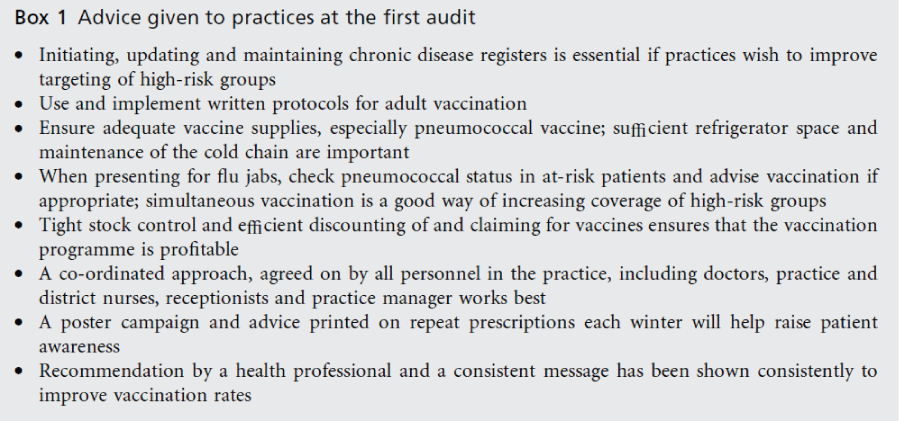
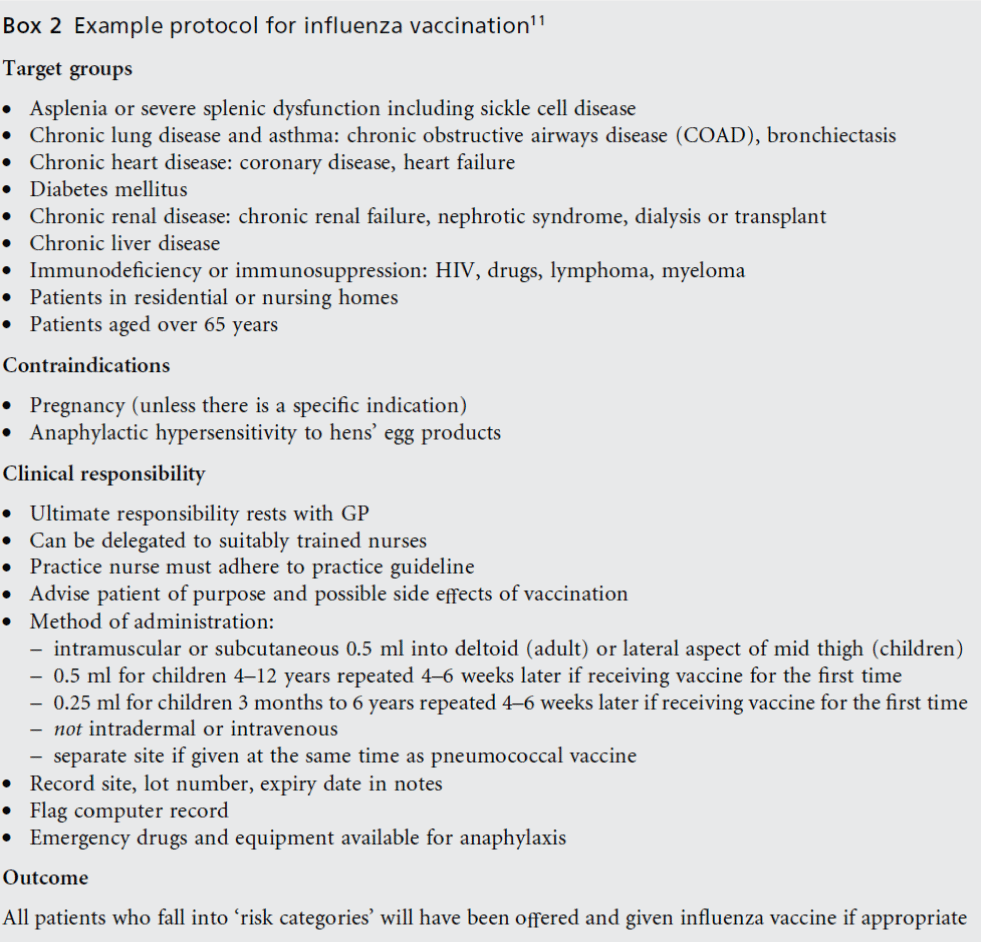
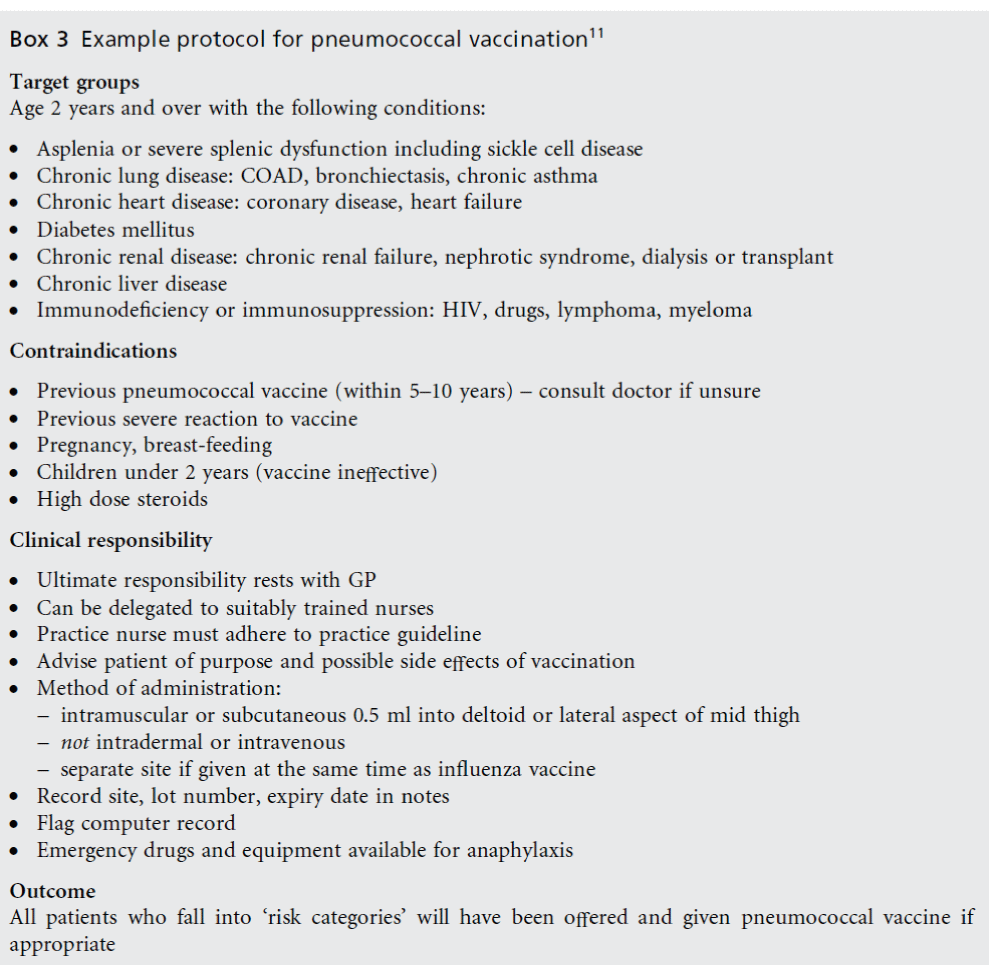
Effects of change
The audit was repeated between January and February 2000. This allowed just over a year for practices to assess and compare their vaccination rates, discuss and implement change, conduct a pneumococcal vaccination programme and complete a further winter vaccination programme for in uenza. Twenty-one practices took part in both phases for diabetes and 14 of these for coronary heart disease and splenectomy. All the practices that undertook the baseline assessment completed both phases but a number of practices joined for the second phase. Practices who participated in both phases of the audit were reelective of practices across Lincolnshire in terms of partnership and list size (see Table 1). There were no data for non-participating practices on other criteria such as baseline vaccination rate or deprivation.
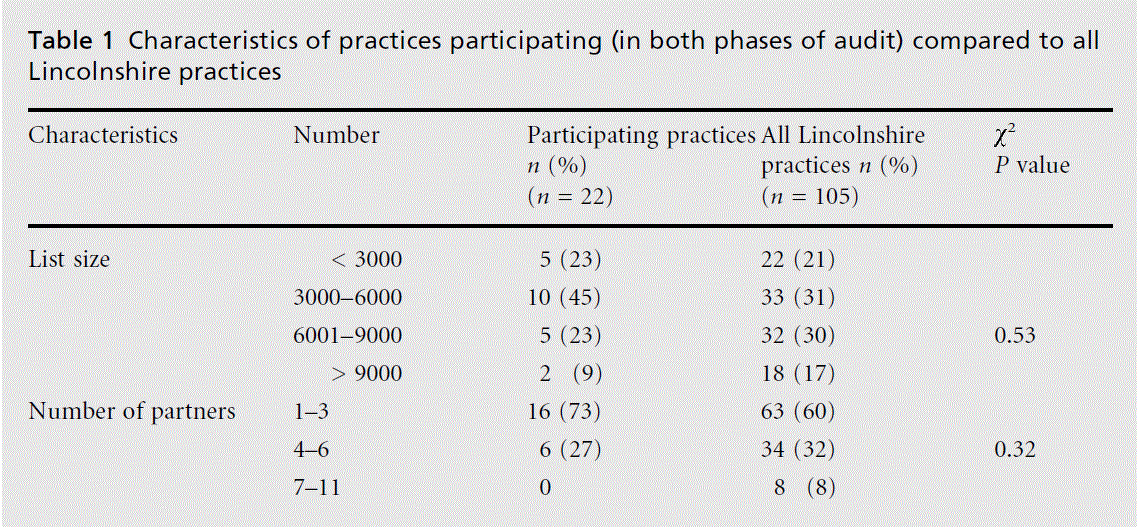
Data were analysed using SPSSPC version 10.[22] Mean values for vaccination uptake were calculated between the two phases of the audit for practices that completed the audit cycle. Performance was com-pared with standards that practices set themselves (expressed as a median standard in Table 2). A paired t test was used to assess improvement in perform-ance. Fourteen practices undertook both phases of the audit for coronary heart disease and splenectomy and 21 practices did so for diabetes. Although a number of practices joined the audit at the re-evaluation phase these were not included in the analysis. Improvements in vaccination uptake occurred in coronary heart disease, diabetic and post-splenectomy patients for both vaccinations (see Table 2).
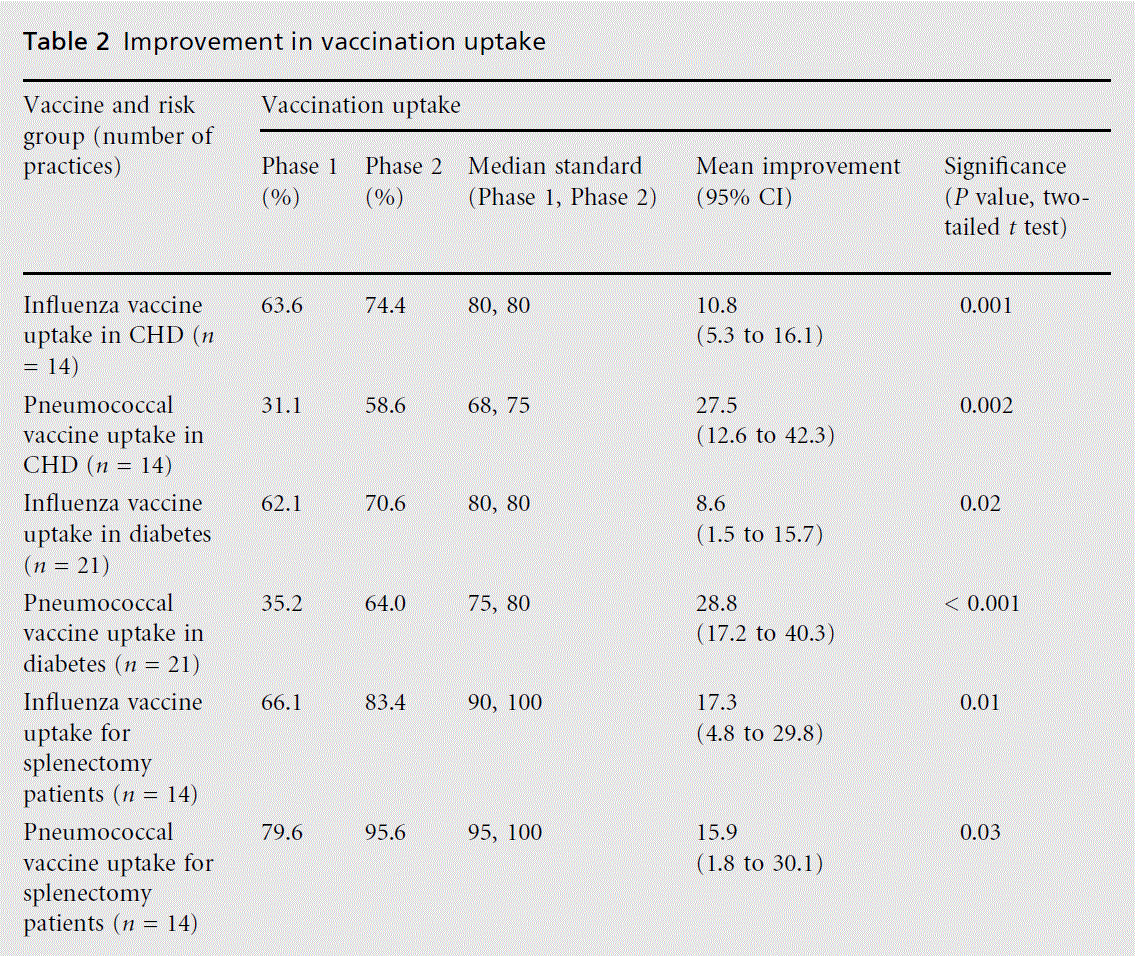
Practices were already using a range of techniques to improve immunisation rates at baseline (see Table 3). We used a semi-structured postal ques-tionnaire to survey organisational changes that occurred in practices as a result of the audit and shared these examples of good practice with other primary care teams (see Box 4).
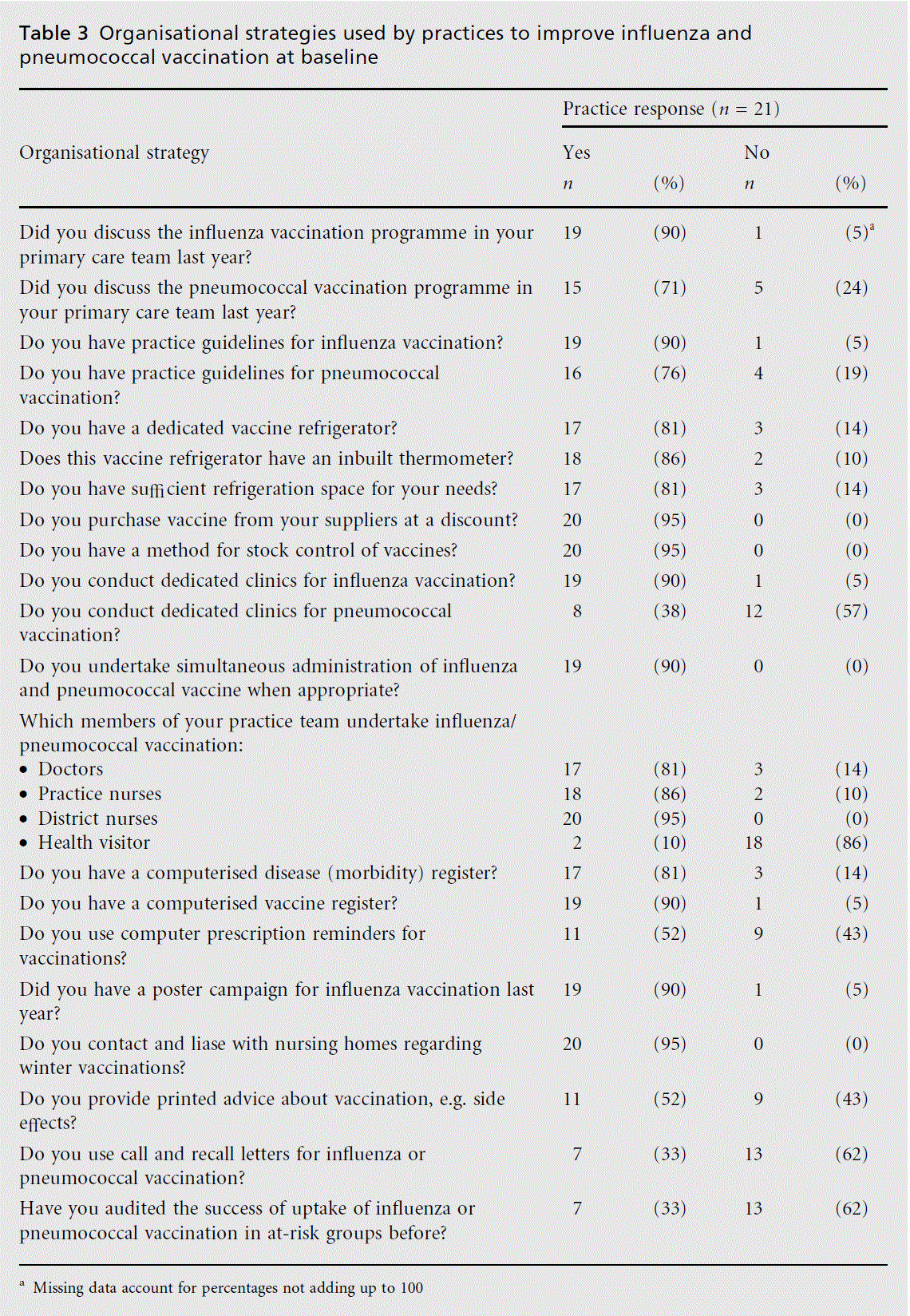
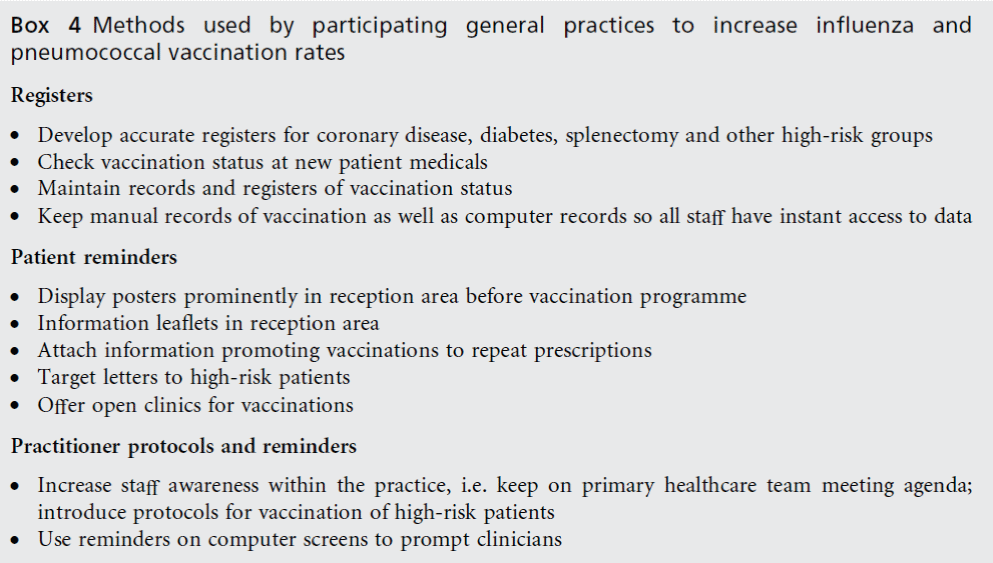
Lessons learnt
Our data showed improvements in influenza and pneumococcal vaccination uptake in high-risk groups using audit, feedback and written advice on strategies for organisational change. There were substantial and signifi cant changes in vaccination rates. The audit demonstrated that volunteer prac-tices could achieve influenza and pneumococcal vaccination rates for disease-specific risk groups comparable to current national targets for influenza vaccination.
This was a multipractice audit in volunteer practices. For diabetes, one-fi fth of the practices in Lincolnshire participated in both cycles. We were disappointed that more practices did not participate. It was likely that those who did take part were more motivated to change. It was possible that non-participating practices may have di¡ered in terms of deprivation or case-mix where the need for immunisation may have been greater but those practices that took part comprised rural, suburban and inner city practices including those serving areas of deprivation. We were not surprised at this level of uptake given previous participation rates in county-wide multipractice audits and other demands in the health service at the time. The data were independ-ently analysed but relied on information sent by practices. Although anonymity of practice and patient was preserved there was a possibility of bias. We could not account for secular trends or the Hawthorne e¡ect. The analysis demonstrates the capability and extent to which participating practices were able to improve performance with the aid of audit, feedback and written advice. Although many practices did not achieve the median standards that they set, they did exceed national targets for influenza vaccination and achieved comparable levels of pneumococcal vaccination. Audit and feedback have been shown to improve immunisation uptake especially when combined with other interven-tions.[23,24] Practices in this study used a range of interventions to improve influenza and pneumococ-cal vaccination rates. In a systematic review of North American studies system-orientated (e.g. standing orders for nurses), provider-orientated (education and/or reminders for doctors and nurses) and patient-directed interventions (lea• ets, posters and mailshots to patients) all improved influenza and pneumococcal vaccination rates.[25] A combination of interventions tailored to overcome practice-specific barriers may be more e¡ective than individual measures particularly when these are focused on organisational change.[26]
Next steps
There is scope for using influenza and pneumococcal immunisation rates as an outcome measure in further rigorous studies to improve vaccine uptake. One opportunity for future research would be to use educational outreach for primary care teams to implement a raft of evidence-based interventions to overcome barriers identified in the practice setting.[27] Benchmarking of practice performance is an import-ant component of clinical governance and will be used increasingly by primary care trusts to monitor and improve performance.[28]
We thank the Lincolnshire practices that participated in this study, Lincolnshire Primary Care Audit Group and Dr Michael Dewey of Trent Institute for statistical advice and comments.
ANS had the initial idea, designed the study, undertook the data analysis, participated in feedback to practices and prepared the paper. LH and TW helped design the audit protocol and carried out the analysis and collation of audit data and feedback to practices. AR and MJ contributed to the methodol-ogy, design and discussion. All authors contributed to the fi nal analysis, revision and approval of the fi nal version of the paper. ANS is the guarantor for the paper.
Trent Focus assisted with funding for ANS and Lincolnshire Health funded the PCAG. Competing interests: None.